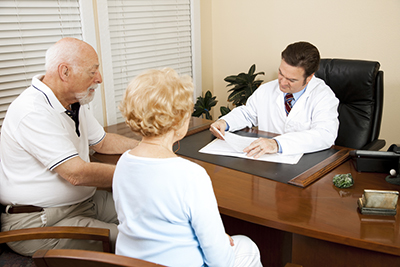
Senior couple with the doctor, going over medical history.
The recent New York Times article, “For New Doctors, 8 Minutes per Patient,” describes a harsh reality that physicians and patients already know too well-that doctor-patient relationships are continuing to suffer due to time constraints. The article references a new study that confirms that doctors in training are spending less time with patients than ever before.
Perhaps the greatest problems that emerge with continually decreasing amounts of time that clinicians can spend with patients include the inability to: 1) obtain sufficient high quality information about the illness and 2) have quality time to establish an effective patient-provider relationship. This can result in inaccurate diagnoses and treatments as well as patient and physician dissatisfaction with each other and the very process of care.
What we are trying to do at the Drossman Center for Education and Practice of Biopsychosocial Care is to communicate the basics of good communication skills to clinicians and patients so that a higher quality of information is obtained and is done in a fashion that builds and strengthens the relationship. It’s not what you do (in the amount of time available) but how you do it that makes the difference.
My vision has been to “translate” the teachings of patient-centered biopsychosocial care to other physicians in practice and training, and now I am able to do that with greater time and opportunity. Almost a decade ago, I became concerned with emerging difficulties in health care, due to an increasing financial burden from growing drug costs, increasing emphasis on ordering expensive and at time unneeded procedures that are highly reimbursed and increased pressures to see more patients in less time.
Read Medicine Has Become A Business.
Medicine as a business has led to a loss in training of the values and skills necessary to enhance patient-doctor communication, and in an erosion of financial support for clinical educators. Most clinicians are not sufficiently trained in patient centered biopsychosocial care, as recommended over a decade ago by the Institute of Medicine. They are not skilled in active listening, making good clinical observation and judgments to effectively diagnose and subsequently work with patients in plans of care that lead to better outcomes. Instead many clinicians approach human illness from a dualistic (i.e., organic vs. functional) perspective, order studies to “rule out organic disease,” or to reduce malpractice suits in a litigious society–even though malpractice suits relate more to poor patient-doctor communication and lack of caring, than to not doing the right tests.
Accordingly, (perhaps in a “Quixotic” fashion) I have sought to improve health care by creating the Drossman Center for Education and Practice of Biopsychosocial Care, which is committed to innovative physician training and education in patient-centered care to enhance physician/patient relationships and improve clinical outcomes.
Our work at the Drossman Center teaches communication skills and ways to improve the patient-doctor relationship. Relying on 30 years of experience, we are presenting lectures and workshops (such as the Rome Foundation AGA Communication Workshop – see previous post) and creating new educational methods through social and digital media.
My goal is to improve health care delivery by achieving physician and patient satisfaction and reducing unnecessary health care costs.
I encourage physicians to contact the Drossman Center to learn more about how our customized educational programs, resources and expertise can help their practices, medical centers and hospitals increase their efficiency, improve patient satisfaction and increase external funding for their health care programs.
Dr. Douglas A. Drossman, MD
 5826 Fayetteville Rd., Suite 201 Durham, NC 27713
5826 Fayetteville Rd., Suite 201 Durham, NC 27713  (919) 246-5611
(919) 246-5611 
